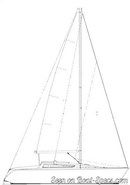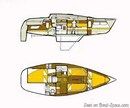Kelt 9m Keel and centerboard
Sailboat specifications
The Kelt 9m is a 29’6” (9m) cruising sailboat designed by Philippe Briand (France). She was built between 1981 and 1985 by Kelt (France). The Keel and centerboard version features a centerboard inside of a short fin-keel allowing shoal draft while maintaining upwind capabilities.
The Kelt 9m is as well listed, on Boat-Specs.com, in Fin keel version (see all the versions compared).
The Kelt 9m is as well listed, on Boat-Specs.com, in Fin keel version (see all the versions compared).
Kelt 9m's main features
- Model
- Kelt 9m
- Version
- Keel and centerboard
- Hull type
- Monohull
- Category
- Cruising sailboat
- Sailboat builder
- Sailboat designer
- Country
- France
- Construction
- GRP (glass reinforced polyester):
- Hull: Single skin fiberglass polyester
- Deck: Sandwich fiberglass polyester - Number of hulls built
- About 100
- First built hull
- 1981
- Last built hull
- 1985
- Appendages
- Centerboard : pivoting centerboard in the keel
- Helm
- Single tiller
- Rudder
- Single spade rudder
- Unsinkable
- No
- Trailerable
- No
- Former French navigation category
- 2
- Standard public price ex. VAT (indicative only)
- N/A €
Kelt 9m's main dimensions
- Overall length
- 29’ 8”9.05 m
- Hull length
- 29’ 6”9 m
- Waterline length
- 24’ 4”7.4 m
- Beam (width)
- 10’3.05 m
- Waterline beam (width)
- 7’ 8”2.36 m
- Draft
- 6’ 2”1.9 m
- Draft when appendages up
- 3’ 2”0.97 m
- Mast height from DWL
- 41’ 8”12.7 m
- Fore freeboard
- 3’ 7”1.11 m
- Mid-ship freeboard
- 3’ 4”1.02 m
- Light displacement (MLC)
- 5688 lb2580 kg
- Maximum displacement (MLDC)
- 7198 lb3265 kg
- Ballast weight
- 2778 lb1260 kg
- Ballast type
- Cast iron exterior ballast with steel centerboard
Kelt 9m's rig and sails
- Upwind sail area
- 535 ft²49.67 m²
- Downwind sail area
- 930 ft²86.42 m²
- Mainsail area
- 198 ft²18.42 m²
- Genoa area
- 336 ft²31.25 m²
- Symmetric spinnaker area
- 732 ft²68 m²
- IiFore triangle height (from mast foot to fore stay top attachment)
- 40’ 5”12.3 m
- JiFore triangle base (from mast foot to bottom of forestay)
- 11’ 6”3.5 m
- PiMainsail hoist measurement (from tack to head)
- 34’ 11”10.65 m
- EiMainsail foot measurement (from tack to clew)
- 10’ 10”3.3 m
- Rigging type
- Sloop Marconi masthead
- Mast configuration
- Deck stepped mast
- Rotating spars
- No
- Number of levels of spreaders
- 1
- Spreaders angle
- 0 °
- Spars construction
- Aluminum spars
- Standing rigging
- 1x19 strand wire continuous
Kelt 9m's performances
- HN (French rating)iHN or "Handicap Nationale" is an empirical rating system used in France allowing various monohulls, of different sizes and designs, to race each other fairly. It is particularly suitable for cruiser and cruiser-racer. Therefore, by comparing these values, we can have an indication of the relative speed of 2 boats.
- 16.0
- Upwind sail area to displacementiThe ratio sail area to displacement is obtained by dividing the sail area by the boat's displaced volume to the power two-thirds.
The ratio sail area to displacement can be used to compare the relative sail plan of different sailboats no matter what their size.
Upwind: under 18 the ratio indicates a cruise oriented sailboat with limited performances especially in light wind, while over 25 it indicates a fast sailboat. - 284 ft²/T26.4 m²/T
- Downwind sail area to displacementiThe ratio sail area to displacement is obtained by dividing the sail area by the boat's displaced volume to the power two-thirds.
The ratio sail area to displacement can be used to compare the relative sail plan of different sailboats no matter what their size. - 494 ft²/T45.94 m²/T
- Displacement-length ratio (DLR)iThe Displacement Length Ratio (DLR) is a figure that points out the boat's weight compared to its waterline length. The DLR is obtained by dividing the boat's displacement in tons by the cube of one one-hundredth of the waterline length (in feet).
The DLR can be used to compare the relative mass of different sailboats no matter what their length:
a DLR less than 180 is indicative of a really light sailboat (race boat made for planning), while a DLR greater than 300 is indicative of a heavy cruising sailboat. - 180
- Ballast ratioiThe Ballast ratio is an indicator of stability; it is obtained by dividing the boat's displacement by the mass of the ballast. Since the stability depends also of the hull shapes and the position of the center of gravity, only the boats with similar ballast arrangements and hull shapes should be compared.
The higher the ballast ratio is, the greater is the stability. - 49 %
- Wetted area
- 191 ft²17.71 m²
- Righting moment @ 1°iThe righting moment is a moment (torque) that tends to restore a boat to its previous position after heeling. Its value corresponds to the torque needed to heel the boat for this angle.
Higher the righting moment is for an angle, greater is the stability. - 359 lb.ft50 kg.m
- Maximum transverse section
- 8 ft²0.77 m²
- Critical hull speediAs a ship moves in the water, it creates standing waves that oppose its movement. This effect increases dramatically the resistance when the boat reaches a speed-length ratio (speed-length ratio is the ratio between the speed in knots and the square root of the waterline length in feet) of about 1.2 (corresponding to a Froude Number of 0.35) . This very sharp rise in resistance, between speed-length ratio of 1.2 to 1.5, is insurmountable for heavy sailboats and so becomes an apparent barrier. This leads to the concept of "hull speed".
The hull speed is obtained by multiplying the square root of the waterline length (in feet) by 1.34. - 6.60 knots
Kelt 9m's auxiliary engine
- Engine(s)
- 1 inboard engine
- Engine(s) power
- 18 HP
- Fuel type
- Diesel
- Fuel tank capacity
- 6.6 gal25 liters
Kelt 9m's accommodations and layout
- Cockpit
- Closed aft cockpit
- Cabin(s)
- 2
- Berth(s)
- 6
- Head(s)
- 1
- Freshwater tank capacity
- 31.7 gal120 liters
- Fridge/ice-box capacity
- 17.2 gal65 liters
- Maximum headroom
- 6’ 4”1.92 m
- Galley headroom
- 6’ 1”1.85 m
- Head headroom
- 5’ 10”1.77 m
Kelt 9m's saloon
- Maximum headroom
- 6’ 1”1.85 m
- Saloon table length
- 4’1.23 m
- Saloon table width
- 2’ 2”0.67 m
- Berth length
- 6’ 4”1.91 m
- Berth width
- 2’0.6 m
Kelt 9m's fore cabin
- Maximum headroom
- 5’ 2”1.58 m
- Berth length
- 6’ 2”1.9 m
- Berth width
- 4’ 2”1.28 m
Kelt 9m's aft cabin
- Maximum headroom
- 5’ 10”1.78 m
- Berth length
- 6’ 4”1.93 m
- Berth width
- 4’ 2”1.27 m
Similar sailboats that may interest you:
Sailboats
First built hull
Hull length
2007
30’ 6”9.3 m
1978
31’ 2”9.5 m
1983
28’ 1”8.56 m
1987
27’ 1”8.25 m
1997
27’ 11”8.5 m
2005
31’9.45 m
1983
30’ 2”9.2 m
1986
29’ 2”8.89 m
2007
30’ 6”9.3 m
1997
31’ 2”9.5 m
2003
32’9.75 m
1981
29’ 6”9 m
1979
30’ 5”9.27 m
2003
32’9.75 m
1979
24’ 11”7.58 m


